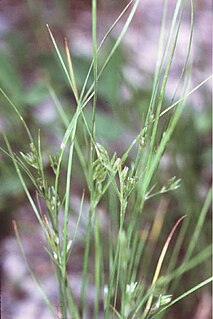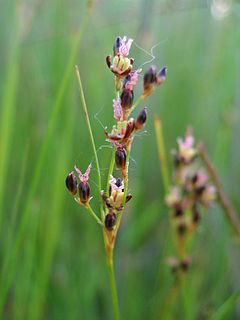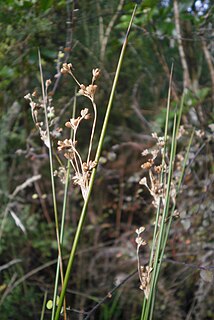
Juncaceae is a family of flowering plants, commonly known as the rush family. It consists of 8 genera and about 464 known species of slow-growing, rhizomatous, herbaceous monocotyledonous plants that may superficially resemble grasses and sedges. They often grow on infertile soils in a wide range of moisture conditions. The best-known and largest genus is Juncus. Most of the Juncus species grow exclusively in wetland habitats. A few rushes, such as Juncus bufonius are annuals, but most are perennials.

Juncus is a genus of monocotyledonous flowering plants, commonly known as rushes. It is the largest genus in the family Juncaceae, containing around 300 species.

Juncus effusus, with the common names common rush or soft rush, is a perennial herbaceous flowering plant species in the rush family Juncaceae. In North America, the common name soft rush also refers to Juncus interior.

Juncus tenuis, the slender rush, is a clump-forming, round-stemmed perennial in the Juncaceae. Slender rush grows to be between 15 and 60 cm tall. Generally considered a weed, it is rarely sold by retailers as a household container plant. Where it is introduced, it is colloquially called path rush, field rush, slender yard rush, poverty rush or wiregrass.

Juncus acutus, the spiny rush, sharp rush or sharp-pointed rush, is a flowering plant in the monocot family Juncaceae.

Juncus articulatus is a flowering plant species in the rush family Juncaceae. It is known by the common name jointleaf rush or jointed rush, which can also refer to J. kraussii from Australia. It is native to Eurasia, Canada, Greenland, and much of the United States. It grows in moist areas, such as wet sand, and thrives in calcareous soils. J. articulatus was found to be more sensitive to drought and salt stress than its congeners J. acutus and J. maritimus. It is a perennial herb producing mainly erect stems from a short rhizome. The stem may root at nodes, and it generally has one or more flattened hollow cylindrical leaves up to 10 centimeters long. Transverse internal partitions or joints may be seen or felt in the leaf of the plant.

Juncus kraussii commonly known as salt marsh rush, sea rush, jointed rush, matting rush or dune slack rush, is of the monocot family Juncaceae and genus Juncus. It grows in salt marshes, estuarine and coastal areas.

Juncus gerardii, commonly known as blackgrass, black needle rush or saltmarsh rush, is a flowering plant in the rush family Juncaceae.

Luzula multiflora, the common woodrush or heath wood-rush, is a species of flowering plant in the rush family.

Juncus acutiflorus, also called sharp-flowered rush, is a rush or a grassy plant of the genus Juncus. As the name suggests, the plant has notable sharp-looking flowers, flowering between July and September.

Juncus edgariae, is a species of rush commonly called Edgar's rush, or wiwi that is native to New Zealand. The most abundant rush species in New Zealand, it also occurs on the Kermadec and Chatham Islands. J. edgariae has been introduced to Britain.

Juncus pallidus, commonly known as the great soft-rushpale rush, giant rush, or leafless rush is a species of rush that is native to southern Australia, New Zealand, Norfolk Island, and Lord Howe Island. It is a vigorous, tufted, tussock-forming, rhizomatous perennial herb with culms growing to 70–135 cm in height. The inflorescence, which is 25–185 mm long, contains many straw coloured flowers, each with six floral segments. It is usually found in moist, nutrient-poor soils subject to periodic flooding, such as fresh and brackish waterways, including swamps, creek banks, lake edges and sand seeps.

Juncus planifolius is a species of rush, commonly known as broadleaf rush, broad-leaved rush, or grass-leaved rush. It naturally occurs in Australia, New Zealand, Hawaii and South America.

Juncus dichotomus is a monocot which belongs to the Juncaceae family of rushes. The plant is native in the Americas in temperate zones but has been introduced to other parts of the world. The species is often confused with other Juncus plants due to morphological similarity. Juncus dichotomus often is found in areas which prove to be very moist, and rainfall is a common occurrence. Juncus dichotomus is often most recognizable in the spring and summer months of the year due to its conspicuous flowers and infructescence.
Juncus ingens, common name giant rush, is a dioecious perennial with horizontal or ascending rhizomes. The stems are erect, dull green, (1.5–2–5 m tall and 4–10 mm in diameter, cataphylls are to 40 cm or more long. The inflorescence is large and drooping, with many flowers scattered along fine branchlets. Flowers occur mostly October-January, seeds are shed mostly December-April. Juncus ingens was first described by Norman Wakefield in 1957. It is one of only two known dioecious species of Juncus native to Australia, the other being Juncus psammophilus.
Juncus biglumis, called the two-flowered rush, is a species of flowering plant in the genus Juncus, native to the subarctic and subalpine Northern Hemisphere. It has three divergent genetic lineages that may represent cryptic species.

Oreojuncus is a small genus of flowering plants in the rush family Juncaceae, found in the eastern United States, eastern Canada, Greenland, Iceland, the Faroes, most of Europe, northern Russia, western Siberia and the Altai. Their chromosome number is 2n=30 (x=15), whereas Juncus, from which they were split, has x=20.

Juncus scirpoides, the needlepod rush, is a species of flowering plant in the family Juncaceae, native to the central and eastern United States. It prefers wet sandy soils, and among the many places it grows it is common in the enigmatic Carolina bays.

Juncus validus, the roundhead rush, is a species of flowering plant in the family Juncaceae, native to the central and southeastern United States. It is a somewhat weedy species, found along wet roadsides and in ditches.
Juncus fascinatus is a species of flowering plant in the family Juncaceae, native to Texas. Its specific epithet refers to Enchanted Rock, where it was first collected.
















